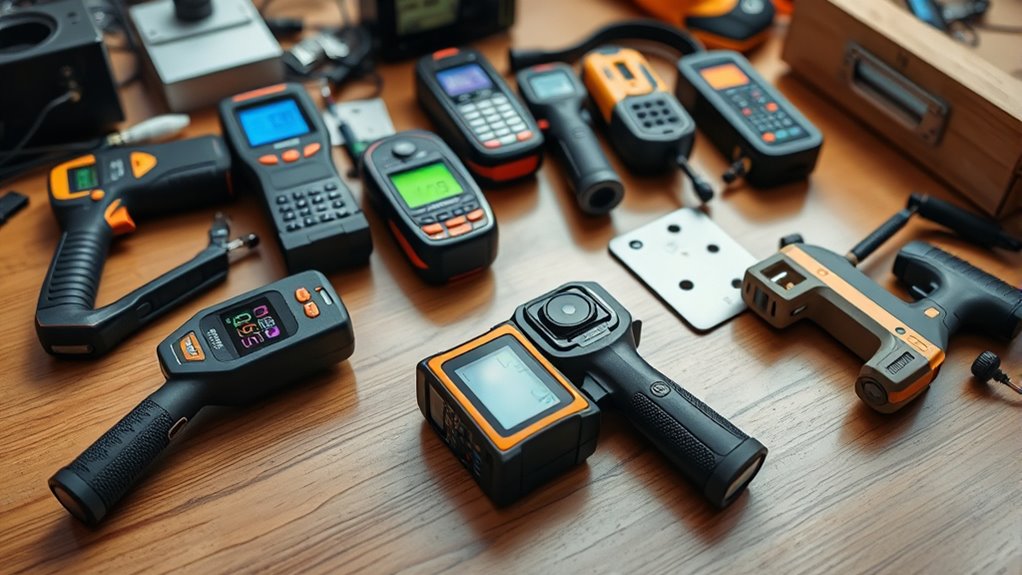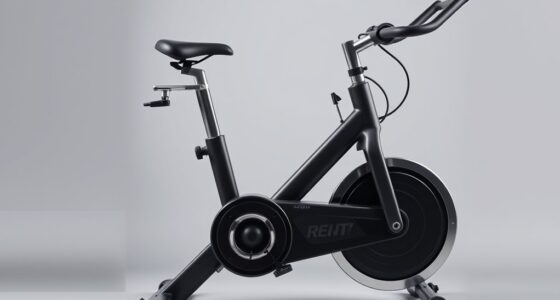If you’re looking for the best stud finders and wall scanners, I recommend options like the Franklin ProSensor MAX and MAX for their high accuracy, deep detection, and easy-to-read displays. The 6-in-1 and 5-in-1 models offer versatile modes, including live wire detection, making wall work safer. For more detailed insights and top picks suited to different needs, stick around, and I’ll help you find the perfect tool for your project.
Key Takeaways
- Look for models with multiple detection modes (stud, metal, live wires) for comprehensive wall assessment.
- Prioritize sensors with high sensor counts and deep detection depths for accurate results in various wall types.
- Choose devices with clear visual displays and audible alerts to simplify operation and improve detection confidence.
- Consider models with automatic calibration and user-friendly interfaces for easier setup and use.
- Select wall scanners with safety features like live wire detection to enhance safety during wall work.
Franklin Sensors ProSensor M210 Stud Finder

If you’re looking for a highly accurate stud finder that’s perfect for both DIYers and professionals, the Franklin Sensors ProSensor M210 stands out. I’ve found it incredibly reliable thanks to its 13 patented sensors, which detect studs more precisely than traditional models. The wide LED display shows the entire width of studs, making it easy to locate centers and edges in one scan. It auto-adjusts for depth up to 1.7 inches and includes live wire detection for safety. Its compact, durable design and quick response time make it a top choice for quick, accurate wall detection on drywall, plaster, or textured surfaces.
Best For: DIYers and professionals seeking a highly accurate, quick, and reliable stud finder for wall framing, electrical safety, and home improvement projects.
Pros:
- Equipped with 13 patented sensors for precise detection of wood and metal studs, reducing guesswork.
- Wide LED display shows the full width of studs, including edges and center, in a single scan.
- Auto-adjusts for depth up to 1.7 inches and features live wire detection for added safety.
Cons:
- Requires fully charged batteries above 1.4 volts, which can be inconvenient with rechargeable NiMH batteries.
- Battery compartment cover can be cumbersome and may loosen over time.
- May produce false positives or ghost detections on irregular or double-layer drywall surfaces.
Digital Stud Sensor 6-in-1 Wall Scanner with Deep Scan
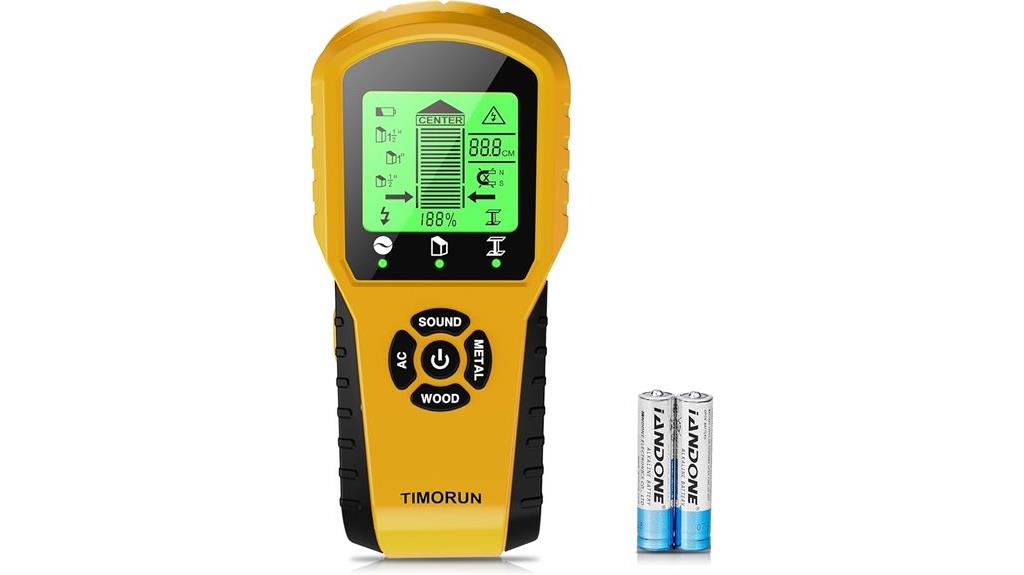
The Digital Stud Sensor 6-in-1 Wall Scanner with Deep Scan is an excellent choice for DIYers and professionals who need reliable, versatile detection in complex wall structures. Its upgraded 6-in-1 digital sensor detects wood, metal, and AC wires, with deep scan capabilities up to 1-1/2 inches through drywall. The HD LCD display ensures accurate readings, while the gear-shaped design makes marking easier. It offers multiple detection modes, including stud, metal, and live wire detection, with adjustable depths. Compact and lightweight, it’s simple to calibrate and operate, making it perfect for safe, precise installations, whether hanging shelves or avoiding hidden hazards.
Best For: DIY homeowners and professionals seeking a reliable, versatile wall scanner for safe and accurate installation and repair projects.
Pros:
- Highly accurate with deep scan capabilities up to 1-1/2 inches through drywall.
- Multi-function detection modes for studs, metal pipes, and live wires, enhancing safety and versatility.
- Compact, lightweight design with an HD LCD display for easy operation and precise marking.
Cons:
- Requires calibration before each use, which may be time-consuming for some users.
- Occasional false readings, especially with metal and wire detection, reported by some users.
- Battery life can vary, with some experiencing faster drain during extended use.
Franklin Sensors ProSensor MAX Stud Finder

For anyone seeking highly accurate stud detection, the Franklin Sensors ProSensor MAX stands out as an excellent choice. Made in the USA, it features 13 sensors, offering superior precision over traditional models with just 1 or 2 sensors. It can detect wood and metal studs up to 2.5 inches deep through thick walls, tiles, drywall, or plaster. The wide LED display shows the entire width of studs, including edges and centers, making locating single, double, or irregular studs straightforward. No calibration is needed, and it’s simple to operate—just press, slide, and see accurate results in seconds. It’s reliable, durable, and perfect for both DIYers and professionals.
Best For: DIYers and professionals seeking highly accurate, reliable stud detection through thick walls, tiles, or multiple drywall layers.
Pros:
- Features 13 sensors for superior accuracy and precise detection of studs.
- Shows the entire width of studs, including edges and centers, on a wide LED display.
- No calibration required, easy to operate, and effective on various wall types and materials.
Cons:
- Larger size compared to some traditional models may be less convenient for portability.
- Uses two AA batteries, which may need replacement over time, though battery life is generally good.
- Higher price point reflects its advanced features, making it less budget-friendly for casual users.
Franklin Sensors ProSensor M150/X990 Wall Scanner with Live Wire Detection
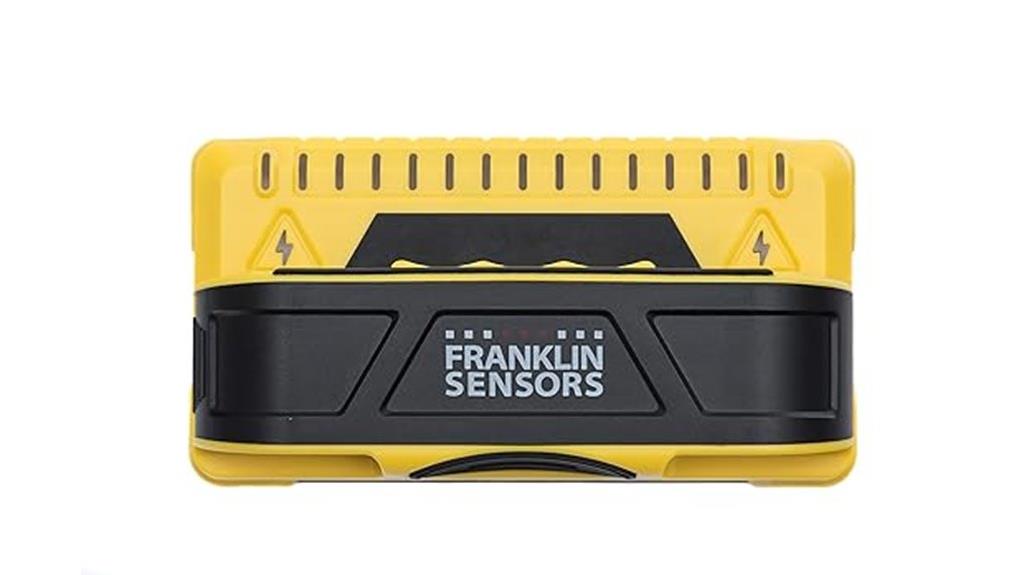
Designed for both DIY enthusiasts and professionals, the Franklin Sensors ProSensor M150/X990 stands out with its advanced 9-sensor array, delivering highly accurate stud detection. It detects full stud widths, including edges and centers, with a maximum depth of 1.5 inches through drywall. The LED display clearly shows full studs, double studs, and irregularities, making it easy to identify exact locations. It also detects live wires with lightning bolt indicators, enhancing safety during installations. The device requires no calibration, is lightweight, and automatically adjusts for different wall materials. Overall, it’s a reliable, user-friendly tool that offers precise wall detection for any project.
Best For: DIY enthusiasts and professionals seeking highly accurate, easy-to-use wall scanning with safety features for wall installations and remodeling projects.
Pros:
- Features 9 sensors for superior detection accuracy of studs and electrical wires
- No calibration needed, making it simple and quick to operate
- Detects full stud widths, edges, centers, and live wires with clear LED indicators
Cons:
- Requires pressing and holding a button during scanning, which some users find inconvenient
- Detection depth is limited to 1.5 inches, potentially missing deeper wiring or studs in thicker walls
- Powered by 2 AAA batteries, which need to be replaced periodically
Franklin Sensors ProSensor M210 Stud Finder
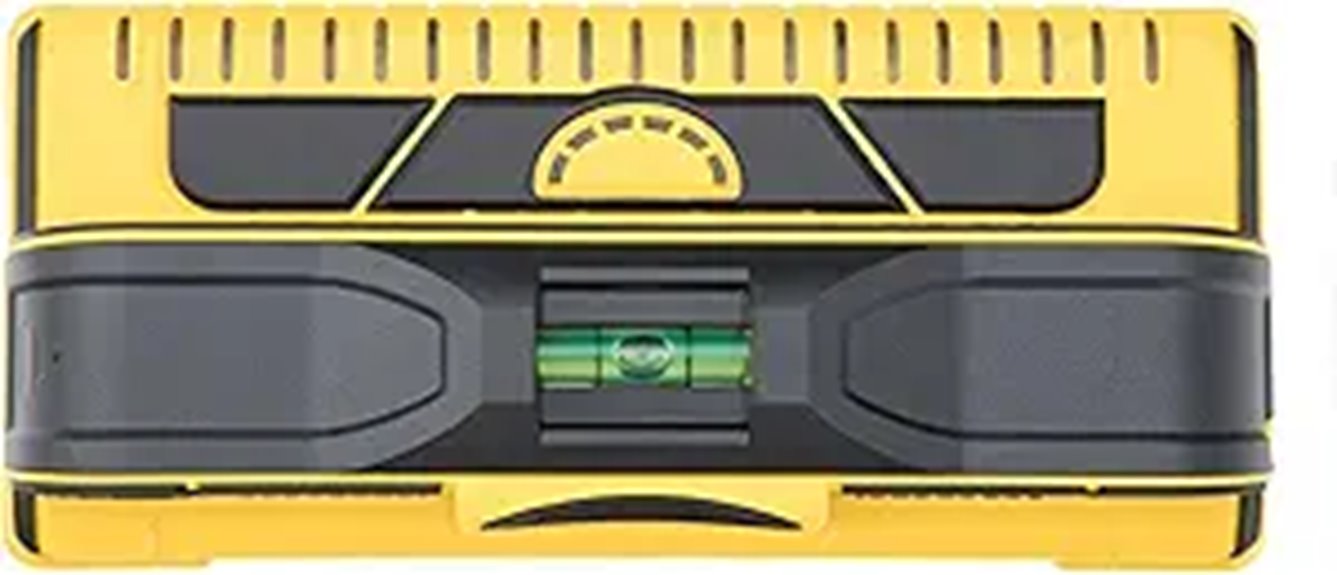
If you’re seeking a highly accurate stud finder that simplifies wall scanning, the Franklin Sensors ProSensor M210 is an excellent choice. It features 13 patented sensors that detect studs more precisely than traditional models, showing the entire width—center and edges—on a wide LED display. It automatically adjusts for depth, material, and texture up to 1.7 inches, and includes live wire detection for safety. Its compact design, durability, and quick response time make it suitable for drywall, plaster, or textured walls. Users praise its reliability and ease of use, making it a top pick for both DIYers and professionals seeking fast, accurate wall detection.
Best For: DIYers and professionals who need a highly accurate, reliable, and easy-to-use stud finder for various wall surfaces and safety detection.
Pros:
- Features 13 patented sensors for precise detection of studs and edges.
- Shows entire stud width, center, and edges simultaneously on a wide LED display.
- Includes live wire detection for added safety during drilling and wall work.
Cons:
- Requires batteries charged above 1.4 volts, which can be inconvenient with rechargeable batteries.
- Cumbersome battery compartment cover that may loosen over time.
- May produce false positives or ghost detections on irregular or double-layer drywall surfaces.
Stud Finder Wall Scanner (5-in-1) with HD LCD Display
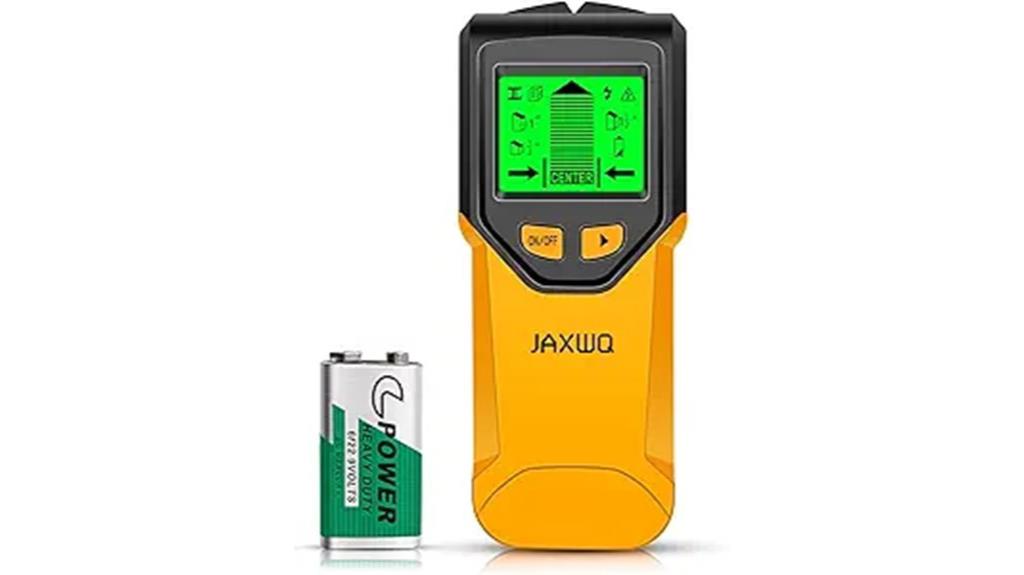
The Stud Finder Wall Scanner (5-in-1) with HD LCD Display stands out as an ideal choice for DIY enthusiasts and homeowners who want reliable, versatile wall detection tools. It combines multiple scan modes—stud, deep, metal, and live wire detection—powered by smart sensors and a microprocessor chip. Its bright, backlit LCD clearly shows object locations, edges, and battery status, making it easy to use even in low light. With audio alerts and simple calibration, it offers quick, accurate readings. Its durable design and included storage make it portable and practical. Overall, it’s a highly reliable tool for safe, precise wall mounting and renovation projects.
Best For: DIY homeowners, home improvement enthusiasts, and professionals seeking a versatile, accurate wall scanner for safe mounting and renovation projects.
Pros:
- Features multiple scan modes including stud, deep, metal, and live wire detection for comprehensive wall assessment
- Equipped with a bright, backlit HD LCD display and audio alerts for easy and precise reading in various lighting conditions
- Durable design with portable storage enhances usability and longevity for both professionals and DIYers
Cons:
- Occasional false positives or inconsistent readings in complex or aged walls, particularly in older homes
- Performance may vary depending on wall conditions, with some users experiencing reliability issues in detecting studs and wires
- Not foolproof; may face challenges in walls with multiple layers or irregularities, requiring cautious interpretation of results
Franklin Sensors ProSensor M150/X990 Stud Finder

For DIY enthusiasts and professionals who need precise wall detection, the Franklin Sensors ProSensor M150/X990 stands out with its advanced 9-sensor array, offering unmatched accuracy. It detects the full width of studs, including edges and centers, with a depth of up to 1.5 inches through drywall. The LED display clearly shows full studs, double studs, and irregularities, making placement straightforward. No calibration is needed—just press and hold the button to scan. Its lightweight, ergonomic design glides smoothly across walls, while LED indicators and live wire detection enhance safety and confidence during installation, ensuring reliable results every time.
Best For: DIYers and professionals seeking highly accurate wall stud and live wire detection with minimal setup.
Pros:
- Features 9 sensors for superior accuracy and full stud width detection.
- No calibration required—simply press and hold to scan, making it easy to use.
- Detects live electrical wires, metal studs, and irregularities, enhancing safety and versatility.
Cons:
- Requires pressing and holding a button during scanning, which some users find inconvenient.
- Uses 2 AAA batteries that are not included, adding an extra step for operation.
- Slightly higher price point compared to basic stud finders with fewer sensors.
Franklin Sensors ProSensor MAX Stud Finder
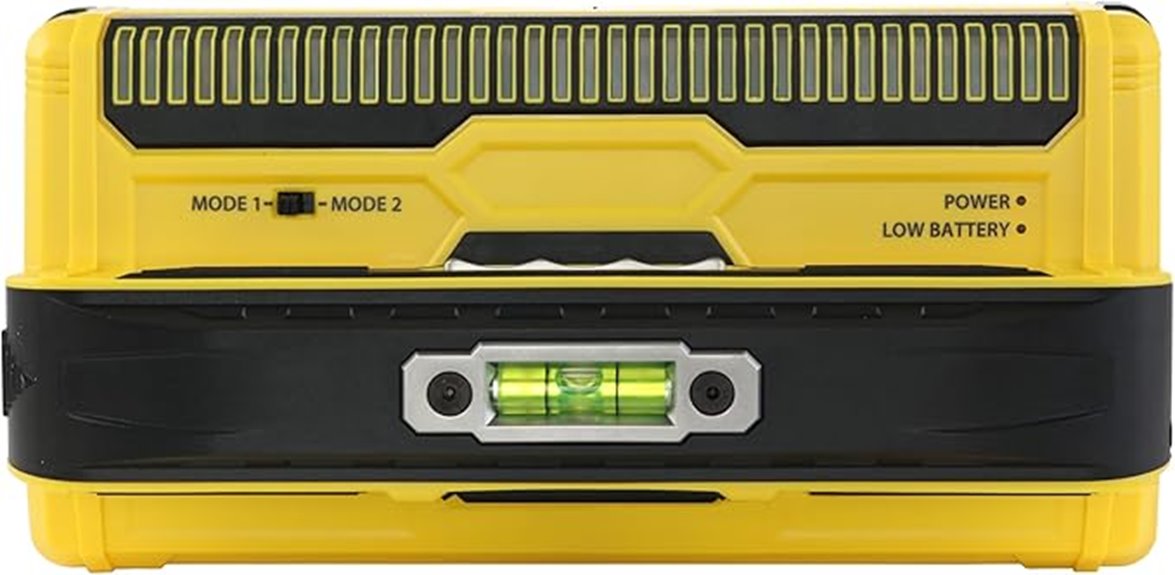
When precision matters, the Franklin Sensors ProSensor MAX stands out as the top choice for DIYers and professionals alike who need reliable stud detection through complex wall structures. With 13 sensors—more than typical models—it delivers superior accuracy, detecting wood and metal studs up to 2.5 inches deep. The wide LED display shows both edges and the center of studs simultaneously, making it easy to mark exact locations. It works effectively through thick walls, tile, and multiple drywall layers without calibration. Durable and simple to use, it quickly identifies studs in challenging conditions, saving time and reducing guesswork during projects.
Best For: DIYers and professionals who need precise, reliable stud detection through complex wall structures and thick materials.
Pros:
- Superior accuracy with 13 sensors for precise detection of wood and metal studs up to 2.5 inches deep
- Wide LED display shows both edges and center of studs simultaneously for easy marking
- No calibration needed; effective through tile, drywall, plaster, and multiple layers
Cons:
- Larger size compared to some traditional models may be less portable
- Requires two AA batteries, which may need replacement over time
- Higher price point compared to basic stud finders, but justified by its advanced features
Stud Finder Wall Scanner, 5-in-1 Multifunction Stud Locator

If you’re looking for a versatile tool that simplifies wall scanning, the Jurgen K Stud Finder Wall Scanner 5-in-1 is an excellent choice. It detects studs, metal, wires, and pipes behind various surfaces like drywall and wallpaper. With upgraded smart sensors, an HD LCD display, and audible alerts, it offers clear visual and sound cues for precise locating. The device features multiple detection modes for different depths, making it suitable for DIYers and professionals alike. Its ergonomic design and straightforward calibration process make it easy to use. Overall, this scanner’s reliability and versatility help you avoid hazards and save time during wall projects.
Best For: DIYers, homeowners, and professionals seeking a reliable, versatile wall scanner for detecting studs, wires, metal, and pipes behind various surfaces.
Pros:
- Accurate and quick detection of studs, wires, metal, and pipes, reducing the risk of damage or hazards
- User-friendly with an ergonomic design, straightforward calibration, and clear visual/audible cues
- Versatile detection modes suitable for different depths and surface types, making it ideal for various projects
Cons:
- Occasional false positives or inaccurate readings, especially in complex wall environments
- Manual calibration can be sensitive; improper handling may affect accuracy
- Limited information in the manual and lack of an online guide may pose challenges for some users
Walabot DIY 2 – Wall Scanner for Studs and Pipes
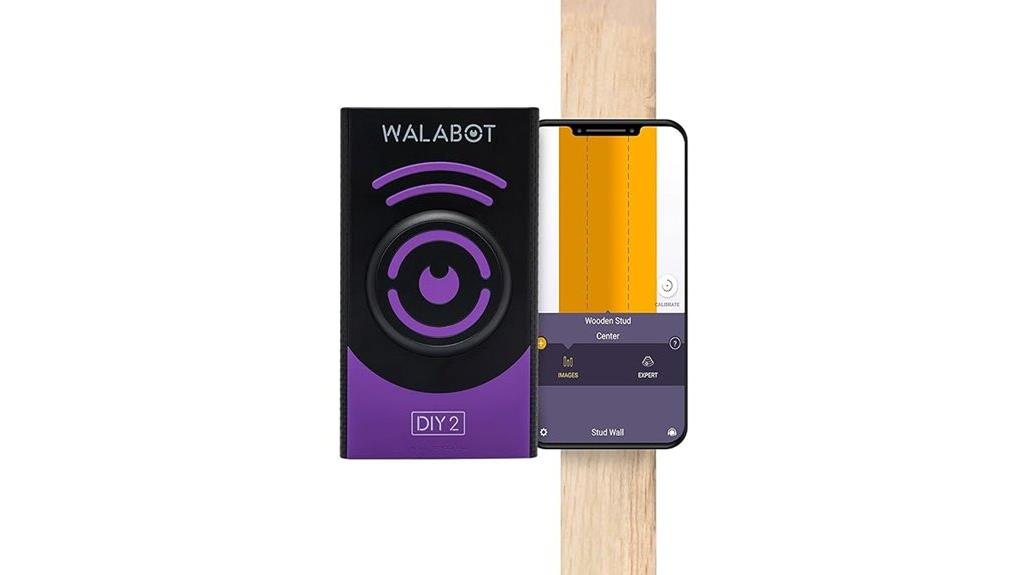
The Walabot DIY 2 stands out as a top choice for DIY enthusiasts and professionals who need precise wall imaging. It detects wood and metal studs, pipes, and wires, offering a visual map of wall contents. Connecting via Wi-Fi to smartphones, it provides real-time detection without relying on your home network. The device works best on drywall, showing the center of studs and pipe paths, even tracking movement inside walls. Though setup requires calibration and may risk paint damage, its quick results help prevent costly mistakes. Despite some connectivity and calibration issues, it’s a powerful tool for accurate wall scanning, especially for those comfortable troubleshooting tech quirks.
Best For: DIY enthusiasts and professionals like electricians, plumbers, and carpenters seeking precise wall imaging for stud, pipe, and wire detection.
Pros:
- Provides real-time visual mapping of wall contents via smartphone connection.
- Accurate detection of studs, pipes, and wires, helping prevent costly mistakes.
- User-friendly setup with quick results, ideal for home improvement projects.
Cons:
- Connectivity issues and unreliable detection depending on phone compatibility.
- Requires calibration for each wall, which can risk wall paint and be inconvenient.
- Lacks an integrated display, often needing two-person operation and troubleshooting.
PREXISO 2-in-1 Rechargeable Laser Level with Stud Finder
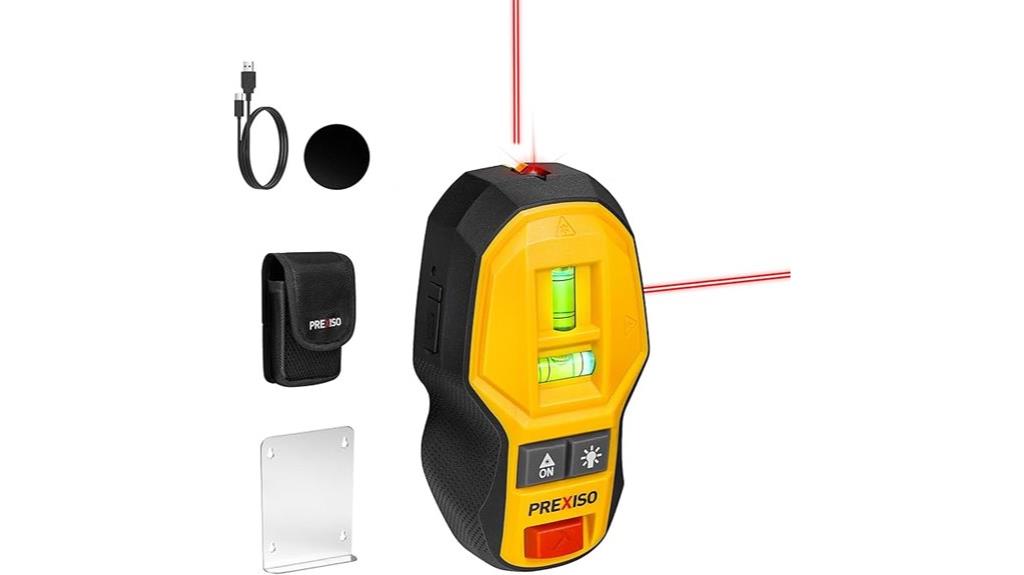
The PREXISO 2-in-1 Rechargeable Laser Level with Stud Finder is an excellent choice for DIY enthusiasts and professionals who want a versatile tool that combines accurate stud detection with precise wall leveling. It features a compact design with three laser modes—cross-line, horizontal, and vertical—that project up to 30 feet, making alignment tasks easier. The magnetic stud finder detects nails and screws in drywall and wood, while LED bubbles assist with leveling even in dark environments. Its rechargeable battery offers five hours of continuous use, and the durable, lightweight construction includes a TPE rubber grip. Overall, it streamlines hanging and mounting projects with reliable laser guidance and basic stud detection.
Best For: DIY enthusiasts and professionals seeking a versatile, rechargeable laser level combined with basic stud detection for indoor hanging and mounting projects.
Pros:
- Combines laser leveling and magnetic stud detection in a compact, lightweight design.
- Provides three laser modes with a visibility range of up to 30 feet, aiding precise alignment.
- Rechargeable battery offers up to 5 hours of continuous use with convenient USB-C charging.
Cons:
- Magnetic stud finder strength may be modest, requiring careful handling or additional methods on thick or old walls.
- Not suitable for detecting pipes, wiring, or metal studs, limiting its versatility in some applications.
- Less effective on lath and plaster walls, which can reduce detection accuracy in older buildings.
Zircon Multiscanner A200 Wall Scanner / Metal Detector / Live AC Wire Detection
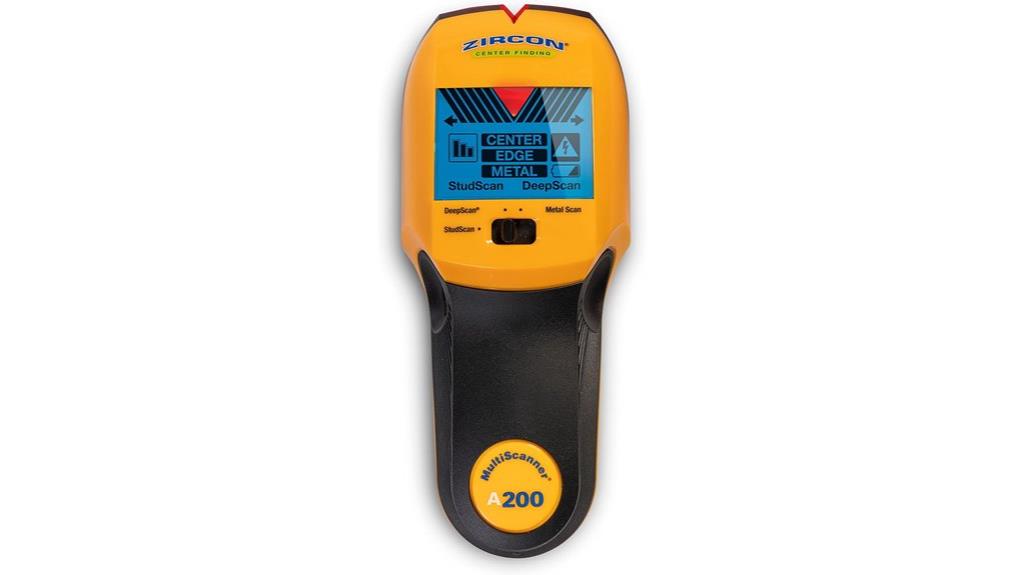
For DIY enthusiasts and professionals alike, the Zircon Multiscanner A200 stands out as a versatile tool that combines stud finding, metal detection, and live AC wire detection in one device. Its digital display and SpotLite pointer enable precise center finding, while the full-feature scanning detects electrical wiring, pipes, rebar, and studs. Weighing just over half a pound, it’s compact enough for easy handling, though some find it a bit bulky. Its IP54 rating guarantees durability against dust and splashes. Overall, the A200 offers reliable performance for common detection tasks, making it a practical choice for home projects and renovations.
Best For: DIY enthusiasts and professionals seeking a versatile, reliable wall scanner for detecting studs, metal, and live electrical wiring during renovation and construction projects.
Pros:
- Combines multiple detection functions (stud, metal, live wire) in one device for convenience
- Features a digital display and SpotLite pointer for precise center finding
- Durable construction with an IP54 rating for resistance to dust and splashes
Cons:
- Some users experience false readings requiring multiple scans for confirmation
- Slightly bulky design may be less comfortable for prolonged handheld use
- Accuracy can be compromised behind dense materials or complex environments
Wall Scanner Metal Detector for Walls and Pipes
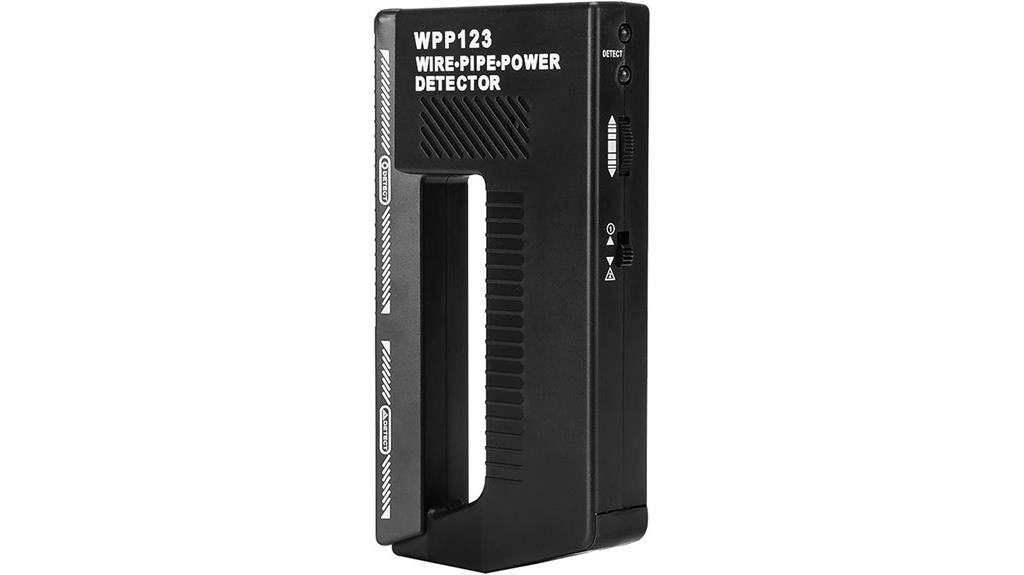
If you’re searching for a reliable wall scanner to detect metal pipes, rebar, or live electrical wires, the Wall Scanner Metal Detector by TITA-DONG stands out with its high sensitivity and adjustable settings. It’s a versatile, lightweight device designed for both professionals and DIY enthusiasts, capable of locating hidden metal behind walls, floors, and ceilings. With visual and audible alarms, you get clear alerts of detected objects. Its adjustable sensitivity helps optimize performance, though customer reviews show mixed results regarding accuracy and reliability. Still, its ergonomic design and ease of use make it a popular choice for those needing precise metal detection during renovation or construction tasks.
Best For: DIY homeowners, construction professionals, and renovation enthusiasts seeking a lightweight, versatile wall scanner to detect metal pipes, rebar, and live electrical wires behind walls, floors, or ceilings.
Pros:
- High sensitivity with adjustable settings for optimizing detection performance
- Visual and audible alarms provide clear, reliable alerts
- Lightweight and ergonomic design for comfortable extended use
Cons:
- Mixed customer reviews regarding accuracy and reliability
- Potential for false alarms or detection issues, especially with units from different sellers
- Some users experience non-functioning sensors or inconsistent detection results
Stud Finder Wall Scanner, 5-in-1 with LCD Display and Smart Sensor
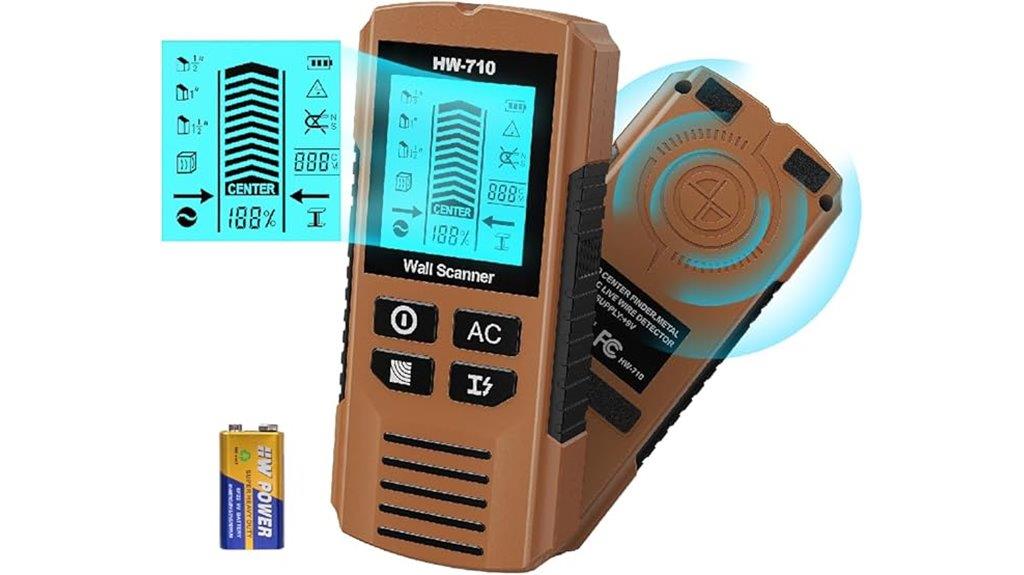
Anyone tackling home improvement projects will appreciate the Stud Finder Wall Scanner, 5-in-1 with LCD Display and Smart Sensor, thanks to its versatile detection modes. It accurately locates wood studs, metal objects, pipes, and live wires behind walls, floors, and ceilings. With five detection modes and an upgraded smart sensor, it provides quick, reliable readings. The bright LCD display shows precise positioning, while audio alerts help confirm findings. Lightweight and easy to calibrate, this device is perfect for DIYers and professionals alike. Its vibrant yellow color makes it easy to spot on the job, ensuring safer, more efficient wall detection every time.
Best For: DIY enthusiasts, homeowners, and professionals seeking a versatile, accurate wall scanner for safe and efficient home improvement projects.
Pros:
- Equipped with 5 detection modes including wood, metal, pipes, live wires, and studs for comprehensive wall scanning
- Features an upgraded smart sensor and HD LCD display for quick, precise detection with visual cues
- Lightweight, compact, and easy to calibrate, making it comfortable to use and suitable for various tasks
Cons:
- May require careful calibration to avoid false readings, especially in complex wall structures
- Limited detection depth compared to professional-grade scanners, potentially missing deeply embedded objects
- The device’s battery life may be limited with extensive use, necessitating replacements or recharging
Stud Finder Wall Scanner 5-in-1
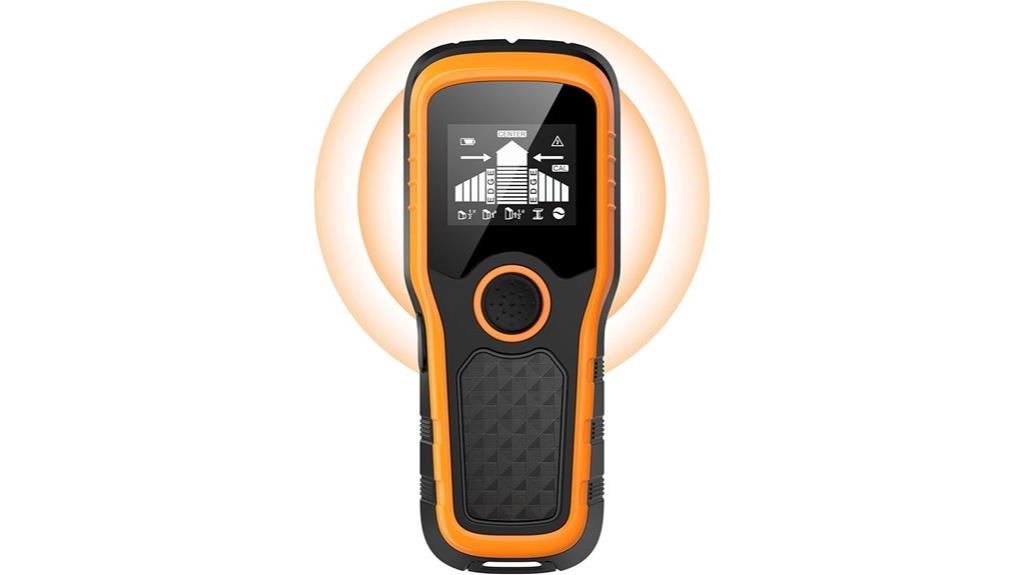
The Stud Finder Wall Scanner 5-in-1 stands out as an excellent choice for DIYers and homeowners who need a versatile tool to detect multiple materials behind walls quickly and accurately. It can identify wood, metal, pipes, joists, and live AC wires with high sensitivity, thanks to its micro-sensor chip. Its adjustable scan modes cover different depths, making it adaptable for various projects. The bright LCD display, audio alerts, and automatic calibration ensure easy operation even in dim environments. Lightweight and ergonomically designed, it offers safety features like live wire detection, helping prevent accidents. Overall, it’s a reliable, user-friendly scanner that saves time and boosts confidence during wall work.
Best For: DIYers and homeowners seeking a versatile, easy-to-use wall scanner for quick and accurate detection of studs, pipes, wires, and other materials behind walls.
Pros:
- High sensitivity and accurate detection of wood, metal, pipes, and live AC wires
- User-friendly with automatic calibration and clear HD LCD display
- Lightweight, ergonomic design with safety features like live wire detection
Cons:
- Sensitivity to wall irregularities may occasionally affect accuracy
- Requires good quality batteries (preferably lithium 9V) for optimal performance
- Some users report interference from electromagnetic fields in certain environments
Factors to Consider When Choosing a Stud Finders Wall Scanner
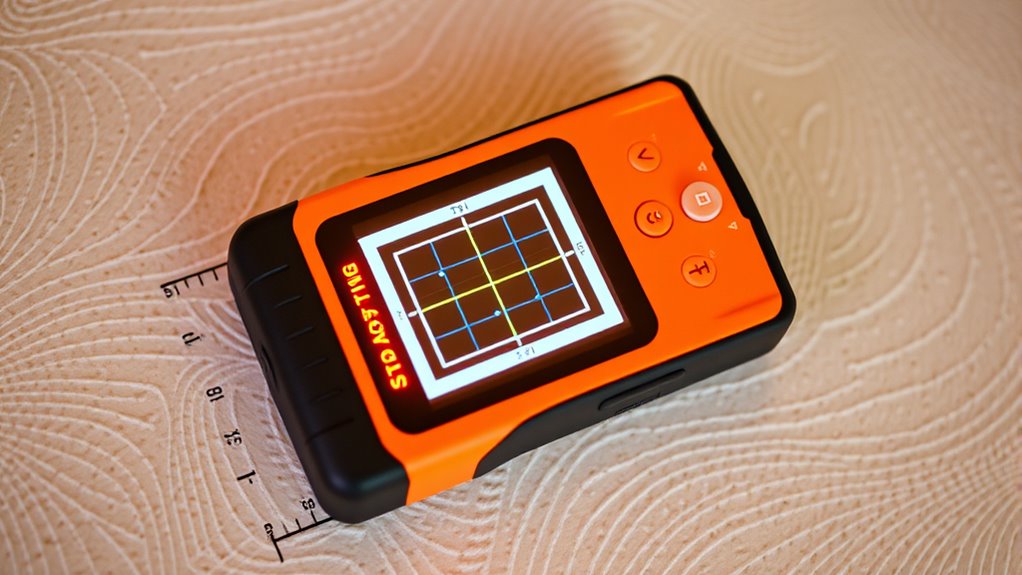
When selecting a wall scanner, I consider factors like detection accuracy and compatibility with different wall materials to guarantee reliable results. Ease of calibration and the depth detection range are also important for efficiency and precision. Additionally, safety features give me peace of mind during use, especially in complex wall setups.
Detection Accuracy Level
Choosing a stud finder with high detection accuracy is essential for precise wall marking and avoiding damage. Accurate devices help you locate studs reliably, reducing the risk of drilling into pipes or wiring. Advanced sensors, such as multiple embedded sensors or microprocessors, markedly improve the device’s ability to distinguish between wall materials and objects, enhancing overall precision. Depth detection capability also plays a role; deeper scans can sometimes decrease accuracy due to signal interference or wall complexity, so finding a balance is key. Proper calibration and consistent scanning techniques are vital to maximize accuracy and reliability. Some models offer visual indicators or multi-sensor systems, providing detailed feedback on stud position and width, which further boosts confidence in your wall detection.
Wall Material Compatibility
Selecting a stud finder that is compatible with your wall material guarantees accurate detection and prevents unnecessary damage. Different surfaces like drywall, plaster, brick, concrete, and wood require specific detection capabilities. Some devices work better with drywall and plaster, while others are designed for brick or concrete. It’s essential to check if the scanner can identify studs behind textured, laminated, or multi-layered walls, which can challenge detection. Additionally, ensure it can handle your wall’s thickness and material density. If you need to find hidden pipes or wires, verify the device supports those materials too. Sensor technology matters—electronic sensors excel with drywall, whereas magnetic sensors work better with wood studs. Matching your wall type with the scanner’s features is key for reliable, damage-free results.
Ease of Calibration
A stud finder that’s easy to calibrate saves you time and reduces frustration, especially if you’re new to DIY projects. Devices with automatic calibration are particularly convenient—they just need to be placed on the wall and activated, making setup quick and simple. Manual calibration models can be more cumbersome, requiring pressing buttons or adjusting settings, which increases the chance of user error and takes more time. Proper calibration is essential because it aligns the device’s sensors with the wall’s conditions, ensuring accurate detection of studs, wires, and pipes. Some models need calibration for different wall types or thicknesses, so choosing a tool with a straightforward, quick calibration process is ideal for versatile use. Ultimately, ease of calibration makes your job smoother and more reliable.
Depth Detection Range
Understanding the depth detection range of a stud finder is essential because it determines how well the device can locate objects hidden behind multiple layers of drywall or thick walls. This range, usually measured in inches or centimeters, indicates how deep into the wall the scanner can accurately detect studs, pipes, or wires. Most models detect up to 1 or 2 inches deep, but professional-grade tools can often reach 3 inches or more. The effectiveness of depth detection depends on sensor technology and wall material; denser surfaces like concrete reduce detection range. When choosing a device, consider your wall thickness and the typical depth of hidden objects. A greater detection range offers versatility and added safety, especially in thicker or more complex wall constructions.
Safety Features Included
Safety features in stud finders enhance user protection by detecting potential hazards behind walls. Live wire detection is essential, alerting you to electrical wires and preventing shocks during drilling or mounting. Visual indicators like LED or LCD alerts clearly signal the presence of hazards such as wires or pipes, ensuring you’re aware before proceeding. Keep in mind, the effectiveness of these features depends on proper calibration and wall conditions; false positives can happen if the device isn’t used correctly. Many models offer multiple detection modes, allowing you to switch between stud, metal, and live wire detection for thorough safety coverage. Incorporating these features greatly reduces the risk of accidental electrical contact or damage, making your wall projects safer and more efficient.
Device Size and Portability
Choosing the right stud finder or wall scanner often depends on its size and portability, especially if you frequently move between job sites or need to store your tools efficiently. Smaller, lightweight models are easier to handle, reducing fatigue during extended use, and they’re simple to carry in a pocket or toolbelt. Compact devices are more convenient for storage and quick access, making them ideal for professionals on the go. Larger models might offer additional features but can be bulky and less comfortable for one-handed operation. When selecting a device, consider your typical project scope and how often you’ll need to transport it. Striking a balance between size and functionality ensures your scanner is both portable and capable of meeting your needs.
Power Source Convenience
When selecting a stud finder or wall scanner, considering the power source is essential for ensuring reliable and hassle-free operation. Most models run on batteries, which can be disposable or rechargeable, offering easy portability. Common battery types include AA, AAA, 9V, or lithium-ion, with some devices requiring specific voltages for best performance. Rechargeable units often feature USB-C or proprietary charging ports, making recharging convenient and eliminating frequent battery replacements. The choice of power source impacts the device’s weight, size, and long-term costs—rechargeables tend to reduce expenses over time. It’s important to choose a device with a power source that’s easy to access, replace, or recharge, ensuring your scanner remains ready whenever you need it.
Additional Safety Alerts
Many wall scanners now come equipped with live wire detection features that alert you to electrical cables hidden behind walls, which is essential for avoiding electrical hazards during your projects. However, the accuracy of these alerts varies; some models may produce false positives or miss wires depending on wall material and wire placement. Combining electrical wire detection with other safety features, like stud or pipe detection, provides a more all-encompassing safety net. Devices often display alerts through visual indicators such as LED lights or LCD screens, helping you identify hazards at a glance. To guarantee safety, always follow the manufacturer’s instructions, perform multiple scans if needed, and avoid relying solely on one feature. Proper use of these alerts greatly reduces the risk of accidental contact with hidden wiring or other hazards.
Frequently Asked Questions
How Accurate Are Electronic Stud Finders Compared to Magnetic Ones?
Electronic stud finders are generally more accurate than magnetic ones because they detect changes in wall density, which helps locate studs behind drywall more precisely. Magnetic models rely on metal objects like nails or screws, which can be less reliable if those aren’t present or are misplaced. I find electronic scanners give me faster, more consistent results, especially when I’m working on new or unfamiliar walls.
Can Wall Scanners Detect Non-Metallic Objects Behind Walls?
Yes, wall scanners can detect non-metallic objects behind walls, like pipes, wiring, or wood studs. They use radar or other imaging technology to identify different materials based on density and electromagnetic properties. I’ve used one myself and was impressed by how accurately it revealed hidden objects without damaging the wall. Just keep in mind, some models are better suited for certain materials, so pick the right scanner for your needs.
Are There Specific Wall Materials That Affect Scanner Performance?
Ever wondered if your wall scanner can handle different materials? Yes, certain wall materials like thick plaster, concrete, or brick can affect its performance. These denser surfaces might make it harder to detect studs or other objects accurately. I always test my scanner on a small area first, knowing that materials like drywall or wood are easier for it to read. Wouldn’t you want your tool to work perfectly every time?
How Deep Can Most Stud Finders Reliably Detect Studs?
Most stud finders can reliably detect studs up to about 1.5 inches deep, though some high-end models reach 3 inches or more. I’ve found that standard magnetic or electronic scanners work well within this range, but their accuracy can decrease beyond that depth. If you need to locate studs deeper in the wall, I recommend investing in a more advanced scanner designed for increased depth detection.
Do Advanced Wall Scanners Require Calibration Before Each Use?
Do advanced wall scanners require calibration before each use? Think of calibration like tuning a musical instrument—it’s essential for perfect harmony. Yes, most advanced models do require calibration to ensure accuracy, especially if they’ve been stored for a while or moved to a different environment. I always recommend calibrating before each use to get the most precise readings, making your wall detection reliable and stress-free.
Conclusion
Choosing the right stud finder or wall scanner makes all the difference, whether you’re hanging a picture or installing shelves. With these top picks, I’ve found tools that are both reliable and easy to use—no need to channel my inner Leonardo da Vinci. Remember, a good scanner saves time and frustration, turning a formidable task into a breeze. So go ahead, pick the one that suits you best—your walls will thank you, and so will your patience!
